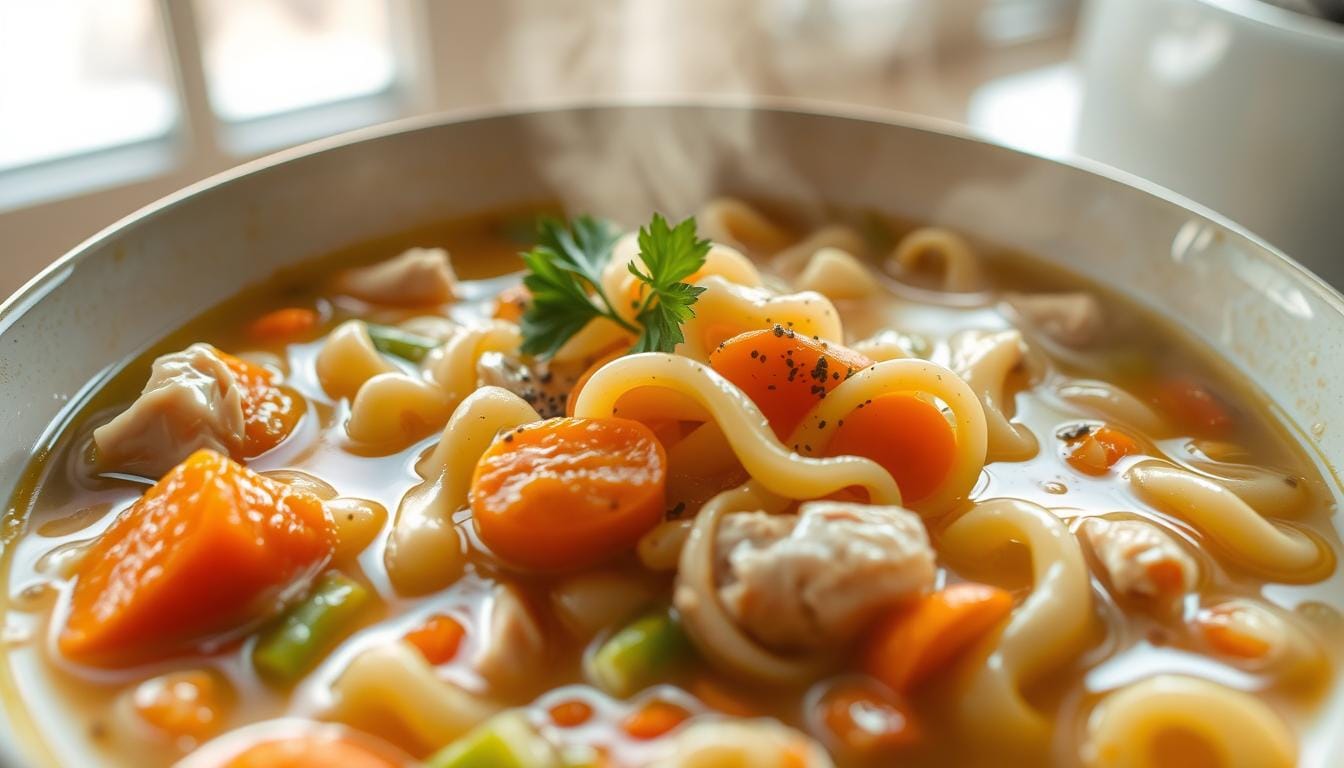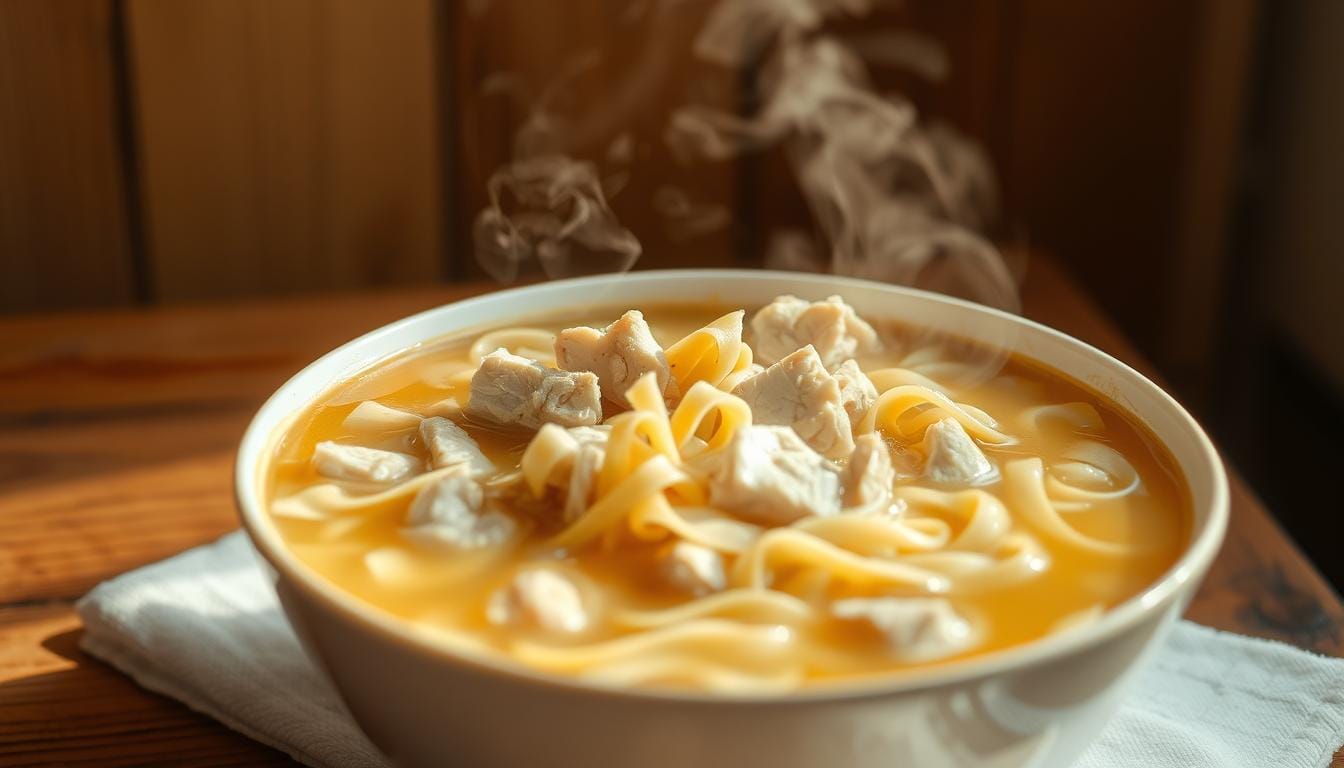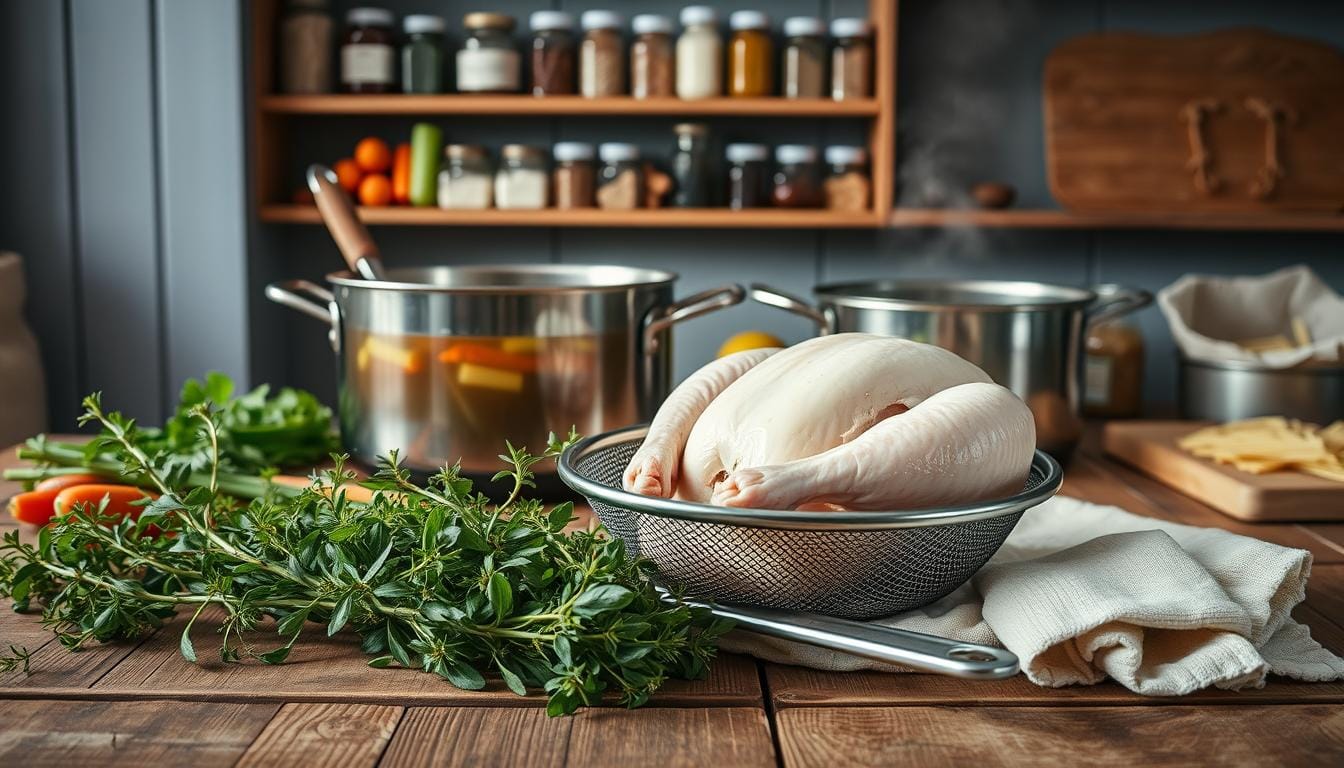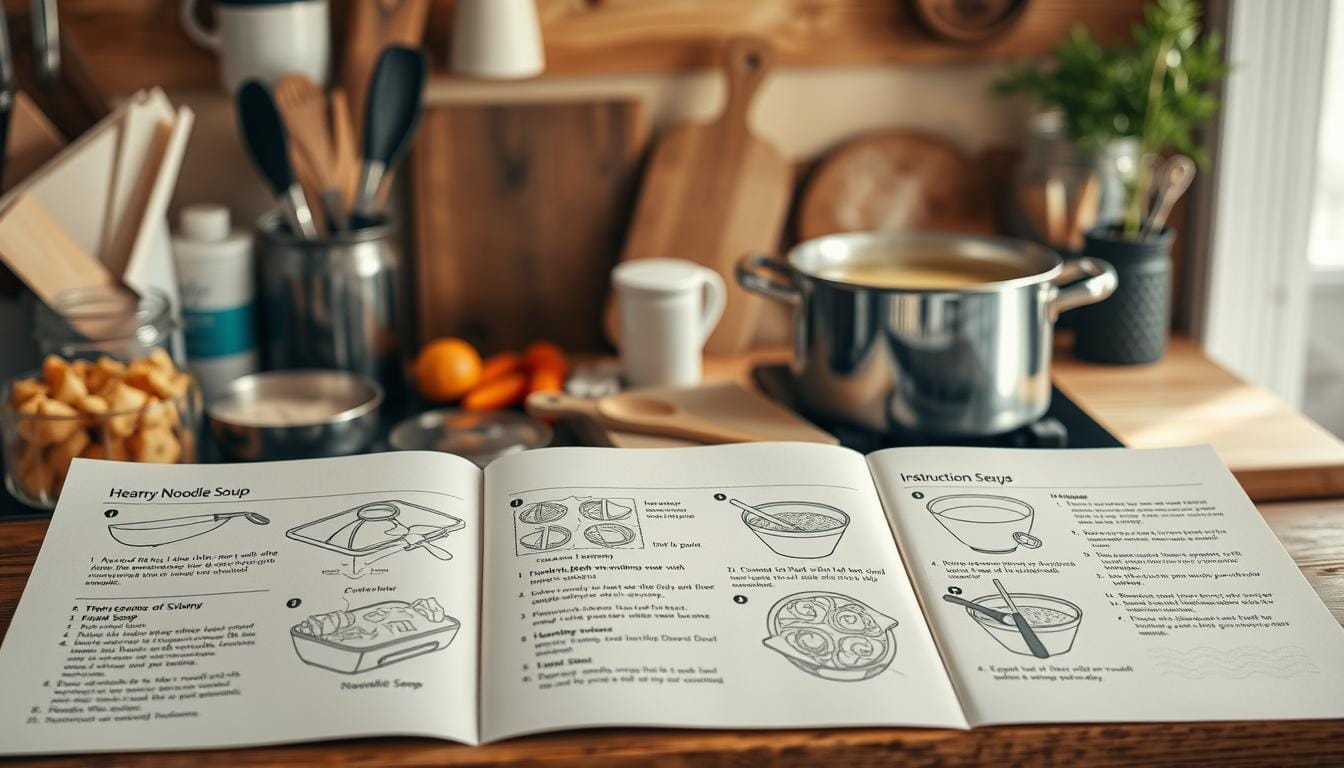
grandma’s chicken noodle soup recipe
There’s something timeless about a bowl of homemade comfort. It’s more than just food—it’s a connection to memories, traditions, and the people who made them. This signature dish, passed down through generations, brings warmth to your table in just over an hour.
With simple ingredients like tender meat, hearty vegetables, and a rich broth, this recipe is both easy to follow and deeply satisfying. Whether you’re cooking for family or craving a taste of nostalgia, this dish delivers every time.
From boiling the perfect egg noodles to simmering the broth to perfection, each step is designed to bring out the best flavors. Let’s dive into the details and make this classic comfort dish your own
Table of Contents
Introduction to a Classic Comfort Dish
Few dishes evoke warmth and comfort like a bowl of this classic dish. Its rich aroma and hearty ingredients make it a favorite for chilly days or when you need a satisfying meal. Whether you’re cooking for family or craving a taste of nostalgia, this dish delivers every time.

grandma’s chicken noodle soup recipe
Why You’ll Love This Hearty Dish
This dish is more than just food—it’s a connection to memories and traditions. The combination of tender meat, rustic noodles, and fresh vegetables creates a balanced flavor that’s hard to resist. Herbs like thyme add a subtle depth, making each spoonful a delight.
What makes it even better is its versatility. You can prepare it on the stovetop or in a pressure cooker, adapting it to your schedule. With minimal ingredients and precise cooking times, it’s a recipe that’s both easy and rewarding.
The Story Behind the Recipe
This recipe has been passed down through generations, becoming a treasured part of family gatherings. Its origins lie in the simple need for a nourishing meal that could be made with readily available ingredients. Over time, it evolved into the beloved dish we know today.
Families have added their own touches, from extra vegetables to unique seasonings. Yet, the core elements remain the same—tender meat, flavorful broth, and comforting noodles. It’s a dish that continues to bring people together, one bowl at a time.
| Nutritional Information (Per Serving) | Amount |
|---|---|
| Calories | 249 kcal |
| Carbohydrates | 22 g |
| Protein | 14 g |
| Fat | 12 g |
| Sodium | 807 mg |
Essential Ingredients and Their Roles
The foundation of any great dish lies in its ingredients. For a hearty and flavorful meal, each component plays a crucial role. From the protein to the vegetables and seasonings, every element contributes to the final taste and texture.

Key Components: Chicken, Noodles, and Vegetables
Start with quality chicken. Bone-in pieces add depth to the broth, while boneless thighs ensure tenderness. For the noodles, egg varieties are ideal. They hold up well during cooking and provide a satisfying chew.
Vegetables like carrots, onions, and celery are essential. They add sweetness, aroma, and a touch of crunch. Fresh produce ensures the best flavor, so avoid pre-cut options if possible.
Selecting the Best Chicken Broth and Herbs
A robust broth is the backbone of this dish. Opt for low-sodium versions to control seasoning. Homemade broth is even better, offering a richer taste.
Herbs like thyme elevate the aroma and flavor. Fresh sprigs are preferable, but dried herbs work in a pinch. A pinch of black pepper adds a subtle kick, balancing the overall taste.
| Nutritional Information (Per Serving) | Amount |
|---|---|
| Calories | 249 kcal |
| Carbohydrates | 22 g |
| Protein | 14 g |
| Fat | 12 g |
| Sodium | 807 mg |
Step-by-Step Cooking Instructions
The key to a flavorful meal lies in mastering the cooking process step by step. From prepping ingredients to controlling heat, each stage contributes to the final result. Let’s break it down to ensure your dish turns out perfectly.

Preparing Your Vegetables and Chicken
Start by washing and chopping your vegetables. Dice the onion, slice the carrot, and chop the celery into even pieces. This ensures they cook uniformly. For the chicken, trim any excess fat and cut it into bite-sized portions.
Next, preheat your pot over medium heat. Add a tablespoon of oil and sauté the vegetables until they soften. This builds a flavorful base for your dish. Season with a pinch of salt to enhance the taste.
Cooking Perfect Egg Noodles
Boil a separate pot of water for the egg noodles. Cook them according to the package instructions, usually around 6-8 minutes. Avoid overcooking to maintain their texture. Once done, rinse them under cool water to stop the cooking process.
If you prefer a thicker broth, dissolve a teaspoon of cornstarch in water and stir it into the soup during the final minutes of cooking. This adds a rich, velvety consistency.
| Nutritional Information (Per Serving) | Amount |
|---|---|
| Calories | 360 kcal |
| Carbohydrates | 22 g |
| Protein | 14 g |
| Fat | 12 g |
| Sodium | 807 mg |
Mastering Grandma’s Chicken Noodle Soup Recipe
The art of crafting a comforting bowl lies in mastering the simmering process. This stage is where the broth and ingredients meld together, creating a rich and flavorful dish. Proper heat control and timing are essential to ensure tender meat and perfectly cooked vegetables.
Executing the Simmering Process
Start by bringing your pot to a gentle boil. Once it reaches this stage, reduce the heat to a low simmer. This prevents the meat from toughening and keeps the noodles intact. Let it simmer for about 20-25 minutes, stirring occasionally.
Monitor the heat closely. A vigorous boil can break down the ingredients too quickly, while a low simmer allows flavors to develop gradually. Add vegetables like onion, celery, and carrot in stages to layer the flavors effectively.
“Simmering is not just cooking—it’s an art that transforms simple ingredients into a masterpiece.”
Achieving the Perfect Flavor Balance
Seasoning is key to a well-balanced dish. Start with a pinch of salt and a dash of pepper. Add a teaspoon of thyme for an aromatic touch. Taste as you go, adjusting the seasoning to suit your preferences.
For a thicker consistency, mix a teaspoon of cornstarch with water and stir it into the broth during the final minutes. This creates a velvety texture that enhances the overall experience. Remember, patience is your best ally in achieving the perfect flavor balance.
Tips, Variations, and Storage Advice
Customizing your favorite comfort dish can make it even more special. Whether you’re adjusting the cooking method or experimenting with ingredients, these tips will help you create a meal that’s uniquely yours.
Recipe Tweaks for Stovetop and Pressure Cooker
If you’re short on time, a pressure cooker can reduce cooking time significantly. Simply set it to high pressure for about 10 minutes, and you’ll have a flavorful meal in no time. For stovetop cooking, simmer the broth on low heat to allow the flavors to meld perfectly.
Feel free to switch up the vegetables. Add a squeeze of lemon for brightness or toss in some spinach for extra nutrients. These small changes can make a big difference.
Freezing, Reheating, and Serving Suggestions
To freeze your dish, store the broth and ingredients separately. This prevents the noodles from becoming mushy. Use airtight containers and leave space for expansion. When reheating, warm the broth first, then add the noodles to maintain their texture.
For serving, garnish with fresh herbs like parsley or a sprinkle of pepper. Adjust the seasoning after reheating to ensure every bowl tastes just as good as the first.
“The beauty of this dish lies in its adaptability—it’s a canvas for your creativity.”
Experiment with additional herbs or spices, but stay true to the classic flavor profile. With these tips, you’ll enjoy a satisfying meal every time.
Conclusion
Creating a comforting meal is both an art and a science. This dish combines simple ingredients like onion, celery, and carrot with a rich broth to deliver warmth and nourishment. By following the step-by-step instructions, you can master the simmering process and achieve a perfect balance of flavors.
Tradition plays a big role in this homemade favorite. It’s a dish that brings people together, whether for a family dinner or a cozy night in. Feel free to experiment with herbs like thyme or adjust the seasoning to suit your taste. The key is to enjoy the process and make it your own.
Thank you for exploring this timeless recipe. We hope it brings as much joy to your table as it has to ours. Serve it with pride, and savor every comforting spoonful.
